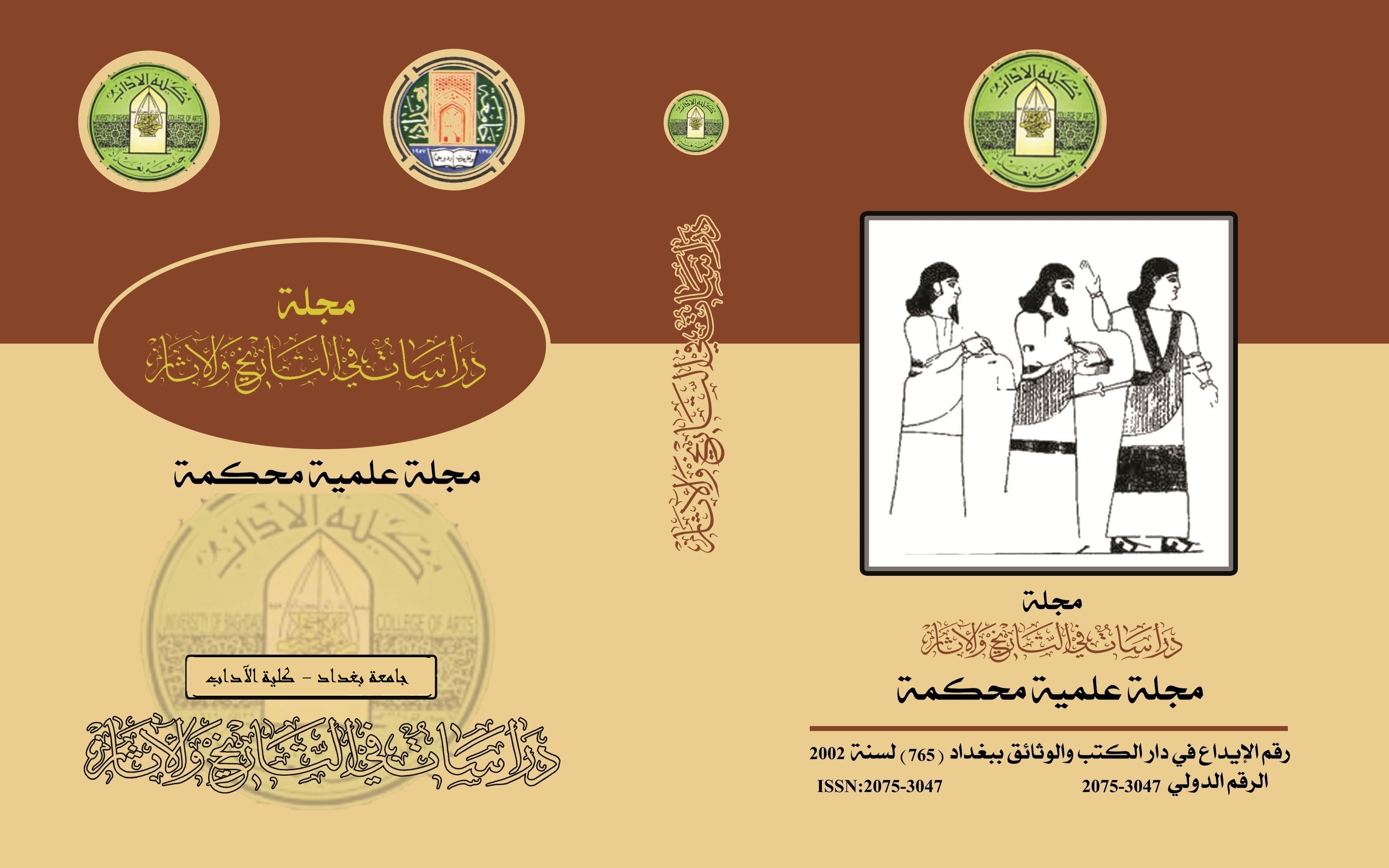مشاهد العزف على الآلات الموسيقية في ضوء مجسمات وألواح غير مدروسة من المتحف العراقي
DOI:
https://doi.org/10.65074/dq9y4n82Keywords:
artistic description, human figures, musical instruments, pottery tablets, Mesopotamian civilizationAbstract
The research studies a collection of terracotta figurines and plaques: two figurines and three plaques. All of them focus on representing the theme of music and playing on musical instruments, due to its significant impact on the human soul. Accordingly, scenes of joy and victory, whether in wars or religious or social events, were represented with great interest by Mesopotamian artists in various forms of art. Musical instruments also varied, including percussion instruments like drums or tambourines, stringed instruments, and even wind instruments. In the selected pieces, the tambourines and the stringed Baz instrument were the main artistic representations. All five pieces date back to the Old Babylonian period (2000-1595 BC), which is considered one of the golden ages in the civilization of Mesopotamia.
References
اولا: المصادر العربية
1. الخياط، أدبية علم الدين، "دراسة مجموعة دمى مكتشفة من تل محمد"، سومر، مج43، ج1-2، 1984.
2. خيري، علي هاشم وامل متاب، انعام عون احمد، "دمى من تلول خطاب دراسة وتقييم"، مجلة سومر، مج50، ج2-1، بغداد، 1999-2000.
3. الرازقي، كرار عامر عطية، دمى والواح فخارية غير منشورة في موقع كرسو، رسالة ماجستير غير منشورة، جامعة الموصل، كلية الأثار،2023.
4. سجل تنقيبات تل محمد الموسم 4، 1981، تسلسل 15، الصفحة 7، الرقم المتحفي للدرس، رقم الحفرية 16.
5. سجل تنقيبات تل محمد، للموسم 1981، تسلسل 60، الرقم الصفحة 20، الرقم المتحفي للدرس.
6. صبحي انور، رشيد، تاريخ الآلات الموسيقية في العراق القديم، بيروت، 1970.
7. عبد الواحد، فاضل، سليمان، عامر، عادات وتقاليد الشعوب القديمة، بغداد 1979.
8. القرة غولي، زينة كريم عبد الله، مشاهد الحياة اليومية في بلاد الرافدين في ضوء الالواح الفخارية، رسالة ماجستير غير منشورة، جامعة بغداد، كلية الاداب، قسم الاثار، 2020.
9. القيسي، ربيع محمود سامي، "مشاهد موسيقية من تل أبو عنتيك مدينة بيكاسي القديمة"، سومر، ج1-2، مج53، (2005-2006).
10. كوركيس، أحلام عبد الاحد، دمى الفخار من موقع سبار، رسالة ماجستير غير منشورة، جامعة بغداد، كلية الاداب، قسم الآثار، 1989.
11. متاب، أمل، وآخرون، تنقيبات تل محمد، سومر، مجلد 46، بغداد، 1989-1990.
ثانيا: المصادر الاجنبية
1. Barrelet, T. Th, figurines et Relives., PI. LIV.
2. Delougaz, P. Pottery From The Diyala Region Chicago, 1952.
3. Hartmann. H., Die Musik Der Sumerischen kulture, frankurt, 1960.
4. Kilmer, A. D, Music and Dancein in the Civilization of Music instruments UK, 2007.
5. Kimer, A.D, Music and Dance in The Civlization of The Ancient Near East (New York, 1995), Vol. VI.
6. Van Buren, E. Clay Figurines of Babylonia And Assyria, London, 1930.
7. Wrede, N. Uruk Terrakotten L. Mainz, 2003, P.304, fig.116. e.
References
1. Al-Khayyat, Adabiya Alam al-Din, "A Study of a Group of Dolls Discovered from Tell Muhammad," Sumer, Vol. 43, Part 1-2, 1984.
2. Khairy, Ali Hashim and Amal Mutab, Inaam Aoun Ahmad, "Dolls from Tellul Khattab: A Study and Evaluation," Sumer Journal, Vol. 50, Part 2-1, Baghdad, 1999-2000.
3. Al-Raziqi, Karrar Amer Attia, Unpublished Dolls and Pottery Tablets at the Site of Karsu, Unpublished Master's Thesis, University of Mosul, College of Archaeology, 2023.
4. Tell Muhammad Excavation Record, Season 4, 1981, Sequence 15, Page 7, Museum Lesson Number, Excavation Number 16.
5. Tell Muhammad Excavation Record, Season 1981, Sequence 60, Page Number 20, Museum Lesson Number.
6. Subhi Anwar, Rashid, History of Musical Instruments in Ancient Iraq, Beirut, 1970.
7. Abdul Wahid, Fadhel, and Suleiman, Amer, Customs and Traditions of Ancient Peoples, Baghdad, 1979.
8. Al-Qaraghuli, Zeina Karim Abdullah, Scenes of Daily Life in Mesopotamia in Light of Clay Tablets, Unpublished Master's Thesis, University of Baghdad, College of Arts, Department of Archaeology, 2020.
9. Al-Qaisi, Rabi' Mahmoud Sami, "Musical Scenes from Tell Abu Antik, the Ancient City of Bekasi," Sumer, Vol. 1-2, No. 53, (2005-2006).
10. Korkis, Ahlam Abdul Ahad, Pottery Dolls from the Site of Spar, Unpublished Master's Thesis, University of Baghdad, College of Arts, Department of Archaeology, 1989.
11. Mutab, Amal, and others, Excavations of Tell Muhammad, Sumer, Vol. 46, Baghdad, 1989-1990.
Downloads
Published
Issue
Section
License

This work is licensed under a Creative Commons Attribution 4.0 International License.
Copyright and Licensing:
For all articles published in Journal of Studies in History and Archeology, copyright is retained by the authors. Articles are licensed under an open access Creative Commons CC BY 4.0 license, meaning that anyone may download and read the paper for free. In addition, the article may be reused and quoted provided that the original published version is cited. These conditions allow for maximum use and exposure of the work.
Reproducing Published Material from other Publishers: It is absolutely essential that authors obtain permission to reproduce any published material (figures, schemes, tables or any extract of a text) which does not fall into the public domain, or for which they do not hold the copyright. Permission should be requested by the authors from the copyrightholder (usually the Publisher, please refer to the imprint of the individual publications to identify the copyrightholder).
Permission is required for: Your own works published by other Publishers and for which you did not retain copyright.
Substantial extracts from anyones' works or a series of works.
Use of Tables, Graphs, Charts, Schemes and Artworks if they are unaltered or slightly modified.
Photographs for which you do not hold copyright.
Permission is not required for: Reconstruction of your own table with data already published elsewhere. Please notice that in this case you must cite the source of the data in the form of either "Data from..." or "Adapted from...".
Reasonably short quotes are considered fair use and therefore do not require permission.
Graphs, Charts, Schemes and Artworks that are completely redrawn by the authors and significantly changed beyond recognition do not require permission.
Obtaining Permission
In order to avoid unnecessary delays in the publication process, you should start obtaining permissions as early as possible. If in any doubt about the copyright, apply for permission. Al-Adab Journal cannot publish material from other publications without permission.
The copyright holder may give you instructions on the form of acknowledgement to be followed; otherwise follow the style: "Reproduced with permission from [author], [book/journal title]; published by [publisher], [year].' at the end of the caption of the Table, Figure or Scheme.



















